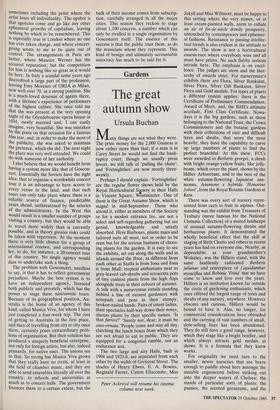Gardens
The great autumn show
Ursula Buchan
Many things are not what they were. The prize money for the 2,000 Guineas is now rather more than that; if a man is in Carey Street he would not find the bank- ruptcy court; though we usually' press levers, we still talk of 'pulling the chain'; and 'Fortnightlies' are now mostly three- weekly.
Perhaps I should explain. 'Fortnightlies' are the regular flower shows held by the Royal Horticultural Soriety in their Halls in Vincent Square, Westminster. One of these is the Great Autumn Show, which is staged in mid-September. Those who attend it, either as members of the Society or for a modest entrance fee, are not a select and self-regarding gathering but are genial, knowledgeable and utterly absorbed. Here Barbours, plastic macs and tailored suits all meet, not in order to be seen but for the serious business of choos- ing plants for the garden. It is easy to see the exhibits, set out along the walls and in islands around the floor, as different from each other as Staffa is from Iona and lona is from Mull: tropical anthuriums next to grey-leaved sub-shrubs and terracotta pots of tiny cushion plants from the high Alps alongside trees in their colours of autumn. A talk with a nurseryman entails standing behind a line of earnest gardeners with notepads and pens in their stumpy, broken-nailed hands. Pairs of intent ladies, their spectacles half-way down their noses, discuss plants by their specific names. 'Is that farreri?"Surely not, dear; it must be sino-orttwa.'People come and stay all day, clutching the lunch boxes from which they are not afraid to eat in public. They are equipped for a congenial ramble, not an endurance test.
The two large and airy Halls, built in 1904 and 1923-8, are separated from each other by the width of Greycoat Street. The shades of Henry Elwes, E. A. Bowles, Reginald Farrer, Canon Ellacombe, Miss Jekyll and Miss Willmott, must be happy in this setting where the very stones, or at least cream-painted walls, seem to exhale an air of fin-de-siecle dowdy prosperity, untouched by contemporary and ephemer- al fashions. Resistance to passing intellec- tual trends is also evident in the attitude to awards. The show is not a horticultural caucus-race where everybody wins and all must have prizes. No such flabby notions intrude here. The emphasis is on excel- lence. The judges are stern and the hier- archy of awards strict. For nurserymen's exhibits there are Flora, Silver Banksian, Silver Flora, Silver Gilt Banksian, Silver Flora and Gold medals. For types of plants a different system applies: there is the Certificate of Preliminary Commendation, Award of Merit, and, the RHS's ultimate accolade, First Class Certificate. Nowa- days it is the big gardens, such as those belonging to the National Trust, the Crown Commissioners and the botanic gardens with their collections of rare and difficult trees and shrubs, that score the most heavily; they have the capability to carve up large numbers of plants to find the perfect branchful. At this show, FCCs were awarded to Berberis georgei, a shrub with bright orange-yellow fruits, like jelly- beans, which cover the plant, shown by the Hillier Arboretum, and to the best of the white autumn-flowering Japanese ane- mones, Anemone x hybrida lionorine Jobert', from the Royal Botanic Gardens at Kew.
There was every sort of nursery repre- sented from cacti to fruit to alpines. Out- standing was the exhibit from Treasures of Tenbury (more famous for the National Clematis Collection) of a muted landscape of unusual autumn-flowering shrubs and herbaceous plants. It demonstrated the wholly beneficial effect that the skill at staging of Beth Chatto and others in recent years has had on everyone else. Nearby, as dependable as your grandmother's Wolseley, was the Hilliers stand, with the same faultlessly cultivated Berberis julianae and centrepiece of Liquidambar styraciflua and Robinia Trisia' that we have come to know and love over the years. Hilliers is an institution known far outside the circle of gardening enthusiasts, which once offered the largest range of trees and shrubs of any nursery, anywhere. However obscure and curious, Hilliers would be bound to have it. Alas, no longer, for commercial considerations have obtruded and the carrying of vast numbers of small, slow-selling lines has been abandoned. They do still have a good range, however, which they stage like a bright bonfire, and which always attracts gold medals at shows. It is a formula that they know works.
For originality we must turn to the smaller, newer nurseries that are brave enough to paddle about here amongst the amiable cognoscenti before striking out into the deeper waters of Chelsea; the stands of particular sorts of plants: the pansies, the scented geraniums, and the aquatics seemed to me the most successful.
One exhibit was of particular interest to those who support the 'listing' of gardens in the same way as buildings. It was staged by the National Council for the Conserva- tion of Plants and Gardens, and showed a range of the plants that the gardening writer Miss Margery Fish grew in her 'cottage garden' at East Lambrook Manor which has recently been listed Grade I. The garden was threatened by sale and development, but has now been bought by someone who wishes to preserve the gar- den and nursery, and continue opening it to the public.
Everybody in London knows of the Chelsea Flower Show in late May. How could they not, with the traffic hold-ups and, on the last day, the sight of swaying rhododendrons in the Underground as if Birnam Wood were on its way to Dunsi- nane again, this time by London Trans- port? Why the Great Autumn Show fails to attract comparable numbers is a mystery to me, for it is a model of what a comprehen- sive flower show should be.



















































 Previous page
Previous page